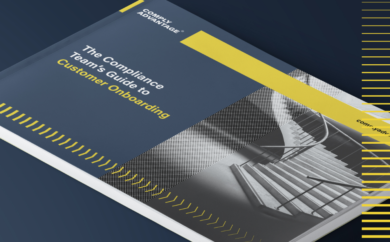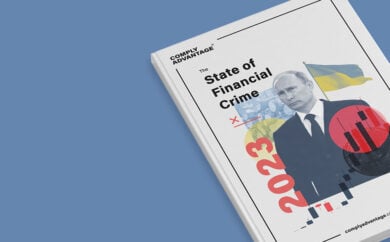In a region where FinTech remains an attractive industry for investors, firms need to be mindful of the critical challenges and opportunities related to anti-money laundering and counter-terrorism financing (AML/CTF) compliance. This awareness can help sustain business growth and preserve the industry's integrity.
To help firms address these key issues, the Guide to Anti-Money Laundering for Canadian FinTechs provides a range of useful guideposts and pointers on approaching common risks.
AML Risks for Canadian FinTechs
FinTechs operating in different spheres may face specific risks related to AML/CTF. Products such as prepaid cards or remittance services can have certain weaknesses that may provide opportunities for money launderers. Therefore, FinTechs need to be aware of the following AML risks and vulnerabilities
- Anonymity: Many FinTech services provide users a higher level of anonymity than traditional services. This can allow criminals to conceal their identities, use stolen identities, or engage third parties to access the legitimate financial system.
- Speed: Electronic money transfers can occur much faster and in greater volume than traditional banking transfers. This makes it easier for criminals to use FinTech products to transfer large amounts of illegal funds and avoid AML investigations by moving those funds around rapidly.
- Regulatory disparity: Criminals may exploit gaps or disparities in AML/CFT regulations by using FinTech services to move funds into or out of Canada. They may also take advantage of disparities in provincial jurisdictions.
- Structuring: Criminals can use different Canadian FinTech products or service providers to engage in multiple transactions, introducing their illegal money into the legitimate financial system without triggering AML measures.
AML Regulations in Canada
In Canada, AML regulations are overseen by the Financial Transactions and Reports Analysis Centre of Canada (FINTRAC). They are governed by the Proceeds of Crime (Money Laundering) and Terrorist Financing Act (PCMLTFA). FINTRAC is the country's financial intelligence unit (FIU) responsible for collecting, analyzing, and disseminating financial information to combat money laundering and terrorist financing. The PCMLTFA outlines the legal framework for AML regulations in Canada. It requires various entities, including FinTechs, to implement measures to identify and report suspicious transactions. These measures include customer due diligence (CDD), record-keeping, and reporting obligations to FINTRAC.
Penalties for Non-Compliance
Failure to comply with the PCMLTFA may result in criminal charges or administrative monetary penalties (AMPs). FINTRAC may impose AMPs to encourage compliance and promote a behavior change. The AMP ranges for minor, serious, and very serious violations are:
- Minor violation: $1 to $1,000.
- Serious violation: $1 to $100,000.
- Very serious violation: $1 to $100,000 per violation for an individual and $1 to $500,000 per violation for an entity.
FINTRAC will take a reasonable approach in calculating penalty amounts proportional to the harm done.
Core AML Compliance Requirements for Canadian FinTechs
To foster a secure financial environment while meeting regulatory requirements, Canadian FinTechs must establish a proactive and effective AML compliance framework. To do this, firms should do the following:
- Appoint an AML Compliance Officer
The appointed AML compliance officer should possess a deep understanding of anti-money laundering regulations, financial systems, and emerging risks. This individual should lead the charge in fostering a compliance culture, ensuring AML policies are not only implemented but also ingrained in the company's ethos. - Conduct Customer Due Diligence (CDD)
Establish stringent procedures for identity verification, including know your customer (KYC) practices. This involves verifying customer identities through reliable documentation, monitoring transactions for unusual patterns, and conducting periodic reviews to ensure ongoing compliance. - Develop a Dynamic AML Compliance Program
Firms should implement a comprehensive set of policies that address specific AML risks associated with their operations. This includes transaction monitoring, record-keeping, and reporting procedures. Regularly update the program to adapt to changing regulatory landscapes and emerging threats. - Report Suspicious Transactions (STRs)
Institute clear and efficient processes for identifying and reporting suspicious transactions. The AML compliance team should be well-versed in recognizing red flags, and reporting to FINTRAC should be prompt and accurate. Regular training and simulated scenarios can enhance response times. - Register with AML Regulators
During the registration process, firms must provide detailed information about their ownership structure, key personnel, and business activities. Maintain open communication with regulators, promptly updating them on any material changes within the organization. This proactive approach establishes trust and cooperation. - Navigate and Mitigate Risks
Implement a robust risk management framework that identifies, assesses, and prioritizes AML risks. Regularly conduct risk assessments considering factors such as customer profiles, geographical locations, and types of transactions. Develop and implement mitigation strategies to address identified risks effectively.
Compliance Challenges for FinTechs in Canada
For FinTechs to mitigate risk and remain compliant, it is essential to know and understand the challenges they face. These challenges include:
- An ever-evolving regulatory landscape: FinTechs in Canada face challenges in navigating a rapidly changing regulatory environment. Keeping pace with evolving AML, KYC, and data protection regulations requires continuous monitoring and adaptation, demanding significant resources and agility.
- Complexity of cross-border transactions: Given the global nature of FinTech operations, cross-border transactions pose compliance challenges. FinTechs must grapple with varying regulatory frameworks in different jurisdictions, necessitating a nuanced understanding of international compliance standards.
- Data security and privacy concerns: FinTechs deal with vast amounts of sensitive customer data. Ensuring robust data security measures and compliance with privacy regulations, such as Canada's Personal Information Protection and Electronic Documents Act (PIPEDA), adds complexity and demands continuous diligence.
- Technological innovation outpacing regulation: The rapid evolution of FinTech technologies often outpaces the development of corresponding regulatory frameworks. FinTech companies need to strike a balance between innovation and compliance, anticipating regulatory adjustments to align seamlessly with their technological advancements.
- Lack of standardization: The absence of standardized regulatory requirements across the FinTech sector poses challenges. FinTechs often deal with a patchwork of regulations, making compliance efforts more intricate and resource-intensive compared to traditional financial institutions.
- Strategic partnerships and third-party risks: FinTechs frequently collaborate with third-party service providers and establish strategic partnerships. Managing the compliance risks associated with these external relationships, including due diligence and ongoing monitoring, is crucial for maintaining regulatory integrity.
- Operational resilience: Ensuring operational resilience in the face of technological disruptions, cybersecurity threats, or unforeseen events is a continuous challenge. FinTechs must have robust contingency plans and recovery mechanisms to comply with regulatory expectations for uninterrupted services.
Best Practices for Canadian FinTechs to Achieve AML Compliance
To enhance AML compliance measures, strengthen overall risk management strategies, and contribute to a more secure and trustworthy financial ecosystem, Canadian FinTechs may consider incorporating the following best practices into their operations:
- Develop robust customer onboarding processes: Implement stringent KYC procedures during onboarding, ensuring thorough identity verification and due diligence. This sets the foundation for effective AML compliance by understanding the risk profile of each customer.
- Implement ongoing monitoring and transaction analysis: Utilize advanced analytics and monitoring tools to detect unusual patterns or high-risk transactions. Firms should regularly review and analyze transactional data to promptly identify and investigate any suspicious activities, aligning with AML best practices.
- Conduct regular employee training and awareness: Educate employees about AML regulations, emerging threats, and the importance of compliance. This could include scenario-based training exercises to simulate real-world situations involving potential AML risks. This practical training equips employees with the skills to recognize and respond effectively to various AML-related scenarios.
- Adopt a risk-based approach: Adopt a risk-based approach to AML compliance, tailoring due diligence and monitoring efforts based on the assessed risk associated with customers, products, and geographic locations. This targeted strategy allows for efficient resource allocation and a more focused compliance effort.
- Integrate automated processes: Leverage technology, such as artificial intelligence and machine learning, to automate AML processes. Automation enhances efficiency in monitoring transactions, flagging anomalies, and managing compliance data, reducing the risk of human error.
- Arrange regular independent audits: Conduct regular independent audits of AML processes and controls to ensure effectiveness and identify areas for improvement. External audits provide an unbiased evaluation, offering valuable insights into the robustness of AML compliance measures.
- Collaborate with regulatory bodies: Foster open communication and collaboration with regulatory bodies, such as FINTRAC. Proactively engage in discussions, seek guidance, and stay informed about evolving regulations to align operations with the latest compliance standards.
- Implement a whistleblower program: Establish a whistleblower program that allows employees to report concerns related to AML compliance without fear of reprisal. This creates an internal mechanism for early detection and resolution of potential compliance issues.
AML Solutions by ComplyAdvantage
AML and anti-fraud solutions are crucial for FinTechs to maintain compliance and manage risk effectively. When evaluating potential vendors, it is important to consider the following key features and capabilities:
- Machine learning integration for real-time analysis: FinTechs should prioritize AML solutions that seamlessly integrate machine learning algorithms. This integration empowers real-time analysis of extensive datasets, enabling swift and accurate detection of suspicious activities. The dynamic nature of machine learning ensures adaptability to evolving patterns, enhancing the overall efficacy of AML processes.
- Advanced transaction monitoring with algorithmic precision: Implement advanced AML solutions to elevate transaction monitoring capabilities. These solutions utilize sophisticated algorithms to scrutinize transactions more effectively, identifying intricate patterns indicative of money laundering activities. The precision of algorithmic monitoring enhances the accuracy of identifying suspicious transactions, reducing false positives, and improving the overall efficacy of AML efforts.
- Comprehensive audit trail capabilities for regulatory assurance: Select advanced AML compliance solutions that offer comprehensive audit trail capabilities. These capabilities allow FinTechs to trace and verify the integrity of their processes. Crucial for regulatory reporting and audits, a robust audit trail provides transparency and accountability, demonstrating the FinTech's commitment to maintaining compliance standards.
- Automated risk assessment for efficient compliance: Embrace AML compliance solutions featuring automated risk assessment capabilities. Automation streamlines the evaluation of risk factors, optimizing processes and ensuring a thorough examination of customer transactions. This efficiency not only enhances compliance but also contributes to a more agile response to emerging risks within the financial landscape.
A key takeaway from the Guide to AML/CFT for Canadian Fintechs is that there is no single right answer to compliance. FinTechs need to understand their obligations and respond to the risks they face, which will vary from firm to firm. For FINTRAC, the vital point is that firms can demonstrate they have sought to apply the rules in ways that help fight criminals and protect customers, rather than simply seeking to do enough to ward off enforcement action.
 Request a Demo →
Request a Demo →
 The Compliance Team’s Guide to Customer Onboarding - Part 1
The Compliance Team’s Guide to Customer Onboarding - Part 1
 The State of Financial Crime 2023
The State of Financial Crime 2023
 ComplyAdvantage Takes on Payment Fraud with New AI-powered Solution
ComplyAdvantage Takes on Payment Fraud with New AI-powered Solution
